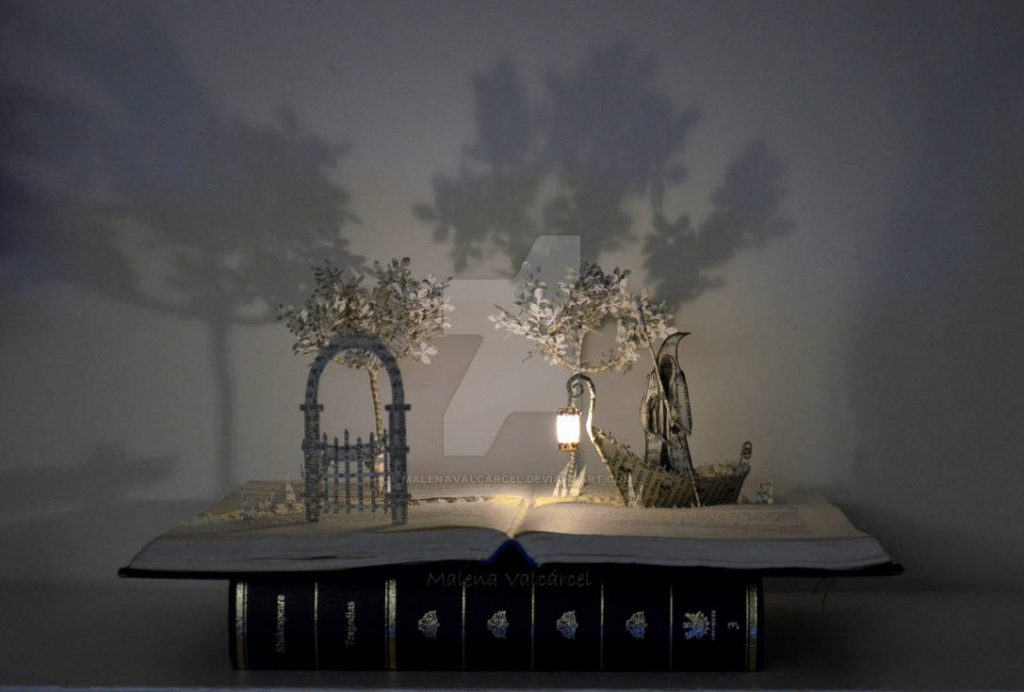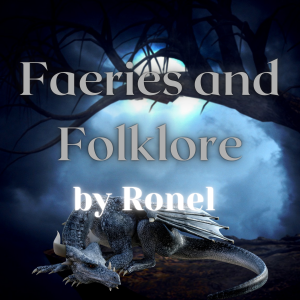V is for Veil


Something, someone, keeps the living and the dead from having to share the same space.
Folklore
The Divine Comedy of Dante [Henry F. Cary, translator (1888)]
Inferno: Canto III
Dante, following Virgil, comes to the gate of Hell; where, after having read the dreadful words that are written thereon, they both enter. Here, as he understands from Virgil, those were punished who had passed their time (for living it could not be called) in a state of apathy and indifference both to good and evil. Then, pursuing their way, they arrive at the river Acheron; and there find the old ferryman Charon, who takes the spirits over to the opposite shore; which, as soon as Dante reaches, he is seized with terror, and falls into a trance.
Encyclopedia of Fairies in World Folklore and Mythology by Theresa Bane
The White Ladies
The white ladies are both a type of ghost and a fairy being, as there is a nearly indiscernible separation between fairies and the deceased. Named for their appearance, dressed in long, flowing, silky gowns, they are similar to the Banshee, as they appear near the time of a family member’s death.
In British lore the white ladies were believed to be fairies and sometimes associated with fertility. In German lore they were associated with elves.
Aynia
In Irish folklore Aynia was one of the Sidhe and the Fairy Queen of Ulster and Tyrone in Northern Ireland. One of her sacred places was a large stone located near Dunany called Aynia’s Chair… the stone was believed to attract rabid dogs and people with mental illness. They were said to gather there and linger about until a great compulsion overtook them to walk out into the ocean and to the underwater lands of Aynia.
The One with the White Hand
In Somerset, England there was a malignant nature spirit who lived on the moors within the birch trees by the name of the One with the White Hand. Described as looking like a gaunt and pale young maiden, she darts from tree to tree and waylays any young man she happens upon. If she touches his head he will go insane but if she touches his chest he will die instantly.
Carlin
In Scotland Carlin (“old woman”) is the spirit of Samhain (Halloween) eve. At the end of the harvest, the last sheaf of barley or corn is cut and dressed up to look like her, an old woman, and hung inside the home to ward off evil spirits.
*More can be read in the book.
The Encyclopedia of Celtic Mythology and Folklore by Patricia Monaghan
Oweynagat
Irish mythological site… for apparitions were said to appear there, especially on the magical Celtic festival of Samhain (November 1) when the veils between the worlds were thin and even those without second sight could see beyond this world and into the next.
Portals to the Otherworld
The Celtic Otherworld was not a place apart from this world; there was no heaven high above or hell far below. Rather, the Otherworld existed in a kind of parallel time and place, near to this world but not accessible. Certain sites and times, however, offered portals to the Otherworld. Then the veil between worlds, always thin, became even thinner; then people could pass from one world into the other.
Samhain
If we know little of how the ancient Celts celebrated the feast, we have ample evidence of how Samhain was viewed by later peoples. Innumerable legends and ghost stories are linked to the holiday, when the veil between this world and the Otherworld was lifted so that fairies and the dead could come forth, readily visible to even those without second sight.
Ancestors
In Brittany and other parts of France, it was common to water graves with milk, as though the dead needed its nourishment. In Ireland the dead were said to come back and visit – have a drink, smoke a pipe, sit by the fire in their usual chair – on Samhain, the day when the veils between this world and the Otherworld grew thinnest. Food and tobacco were often left out for them. Implicit in such rituals is the idea that, if unattended to, the dead may grow angry and cause disruptions in the earthly world.
*More can be read in the book.
The Element Encyclopedia of 5000 Spells by Judika Illes
Once upon a time, crossroads were where people met, where nomads rendezvoused, where gallows stood, where the death penalty was enacted and corpses left to hang, where suicides were buried. If magic spells were cast according to direction, then midnight at the crossroads must have frequently been a crowded, busy place, especially on a night like Halloween when the veil that divides the realms of living and dead is at its most permeable, leaving an open road for inter-realm communication.
Dumb Supper Spells
Do you wish to dine with Dr. Dee, Madame Blavatsky and Mamzelle Marie Laveau? Invite them! Perhaps you’d rather share a meal with your late greatgrandmother. Invite her, too! Dumb Suppers are ritual meals enacted between living and the dead. “Dumb” indicates not lack of intelligence but that these meals (and any communication) are conducted in silence. While the dead are formally invited to attend, all cooking and serving is done by the living. Although a dumb supper may be served at any time, traditionally they are scheduled to coincide with Halloween, the time of year when the veil between realms is thinnest. Extend specific invitations, or allow yourself to be surprised by who shows up.
Samhain Hungry Ghost Spell
Samhain, the Celtic roots of Halloween, marks the beginning of the dark, incubatory half of the year. It’s also the moment when the veils between realms of living and dead are sheerest. Thus it’s the time around the world to contact one’s ancestors, pay tribute and honor to them, and engage in necromantic practices of various kinds. Hungry ghosts are also believed to abound—those without family or friends to feed and remember them.
Place offerings of milk and barley outside under the stars to ease the ghosts’ hunger, prevent their mischief, and to accrue their blessings.
*More can be read in the book.

The Element Encyclopedia of Witchcraft by Judika Illes
The periods when the veil between realms is thin and dead souls return to visit the living: Halloween, Yule, and Lupercalia.
Halloween: See also Festivals of the Dead and Samhain. Also known as All Hallows, All Hallowmas, All Saints’ Day, Hallowtide, and November Eve. No night is more identified with witchcraft, magic, spirits, and ghosts. This is the night when the veil between realms is so thin as to be nonexistent. It is thus the perfect night for divination, magical ritual and spells, petitions to spirits and communication with the dead.
Yuletide refers to the two-month tide corresponding to modern December and January. The winter solstice falls within this period, as does the 12-day period commemorated as the Twelve Days of Christmas. Similar to Halloween or the February Feasts of Purification, the veil between realms is thin during this time and ghosts and spirits walk the land.
*More can be read in the book.
The Encyclopedia of Witches, Witchcraft and Wicca by Rosemary Ellen Guiley
Samhain marks the third and final harvest, and the storage of provisions for the winter. The veil between the worlds of the living and the dead is at its thinnest point in the year, making communication easier. The souls of the dead come into the land of the living. Cakes are baked as offerings for the souls of the dead.
*More can be read in the book.
Herbal Magick: A Witch’s Guide to Herbal Folklore and Enchantments by Gerina Dunwich
Take care not to sit beneath the boughs of a hawthorn tree on Halloween (the time of year when the invisible veil between the human and supernatural realms is thinnest), otherwise, you may fall under a fairy enchantment.
*More can be read in the book.

Further Reading:
- The folklore of Halloween
- Divination and the Veil Between Worlds
- The thinning of the veil: Spirit world collides with earthly realm on Halloween
- The Lost Meaning of Halloween
- Samhain
- THE VEIL BETWEEN WORLDS
- Otherworld
- Crossing the Veil: The Pre-Christian Origins of Halloween and Samhain
- Thinking About the Veil Between the Worlds
- Charon
Folklore in a Nutshell by Ronel
Someone in charge of keeping the living and the dead from occupying the same space, making sure everyone is where they should be, and commanding the creatures who keep souls in line has long been the topic of folklore.
The Keeper’s job is most difficult around Samhain when the Veil between worlds are at its thinnest. Some festivities at that time of year, such as Día de los Muertos, is designed to lure souls to visit their living family. Other festivities, though, are designed to keep the souls away – dressing up in costumes and keeping bonfires lit are believed to scare off wandering souls.
In some cultures, the Otherworld kept from the land of the living with the Veil, was also guarded by dogs – most famously Cerberus, the three-headed dog of Hades.
There is a belief in some circles that the Veil is a metaphor for the boundary between the living and the dead, so much so that some call the Veil a hedge, mist or a gate. This, along with ancient beliefs of where the Otherworld exists, confuses people. Is there a veil between the Underworld where you are expected to go down into the earth and where you stand upon it? Is there a veil to cross if you sail west and enter the land of the dead?
Yes.
The Otherworld has many realms, as discussed in another post, and it is the duty of the Keeper of the Veil between worlds to keep the dead in the Otherworld and the living out of it.
In Greek mythology, Charon is the ferryman who takes the dead across the river Styx. But he also took a couple of living there for a fee: Hercules, Odysseus and Theseus to name a few, and they all returned from their adventure in the underworld, alive.
Which means that the Keeper of the Veil has her own agenda at which one can only guess. The Veil, though, has one job and it does it well.
For more information on Ankou, check out this post.
For more about the Keeper’s faithful grims, see this post.
For more information about the Otherworld, see this post.
Keeper of the Veil in Modern Culture
I couldn’t find much (I think if I were to watch/read more horror I’d be more informed) but there is one source of entertainment that has it all:
BBC’s Merlin!
“When she spoke, her voice…it was as though it came from the depths of the earth, and her eyes…they were so sad. So much pain in them”— Merlin on the Cailleach[src]
Learn more about her here.
The Cailleach is the gatekeeper to the spirit world, who appeared after Morgana tore the mystical veil between the spirit world and Albion.
And, of course, Charon (the ferryman) features in Percy Jackson series by Rick Riordan.
Charon (pronounced Care-on) is the Spirit of Boundaries and Territories. He is the ferryman that transports dead spirits to the Underworld.
Learn more here.
Keeper of the Veil in My Writing
Origin of the Fae: Keeper of the Veil
Mistress of the Veil. The Gatekeeper. The Ferryman. She is known by many names in many cultures.
Her job is to keep the Veil between the living and the dead intact, no matter their species.
She resents necromancers as they always chip away at her Veil, making it easier for those who shouldn’t to pass through.
Grimms work for her and act as her protectors and companions.
Though she is affiliated with death, she doesn’t obey anyone and is ruled by none (though Ankou believes she works for him).
Her job also includes making sure that humans hold up their part of the Compact by observing the rites of Samhain, Yule and other festivals.
Translation of Keeper/Mistress of the Veil to Afrikaans: Bewaarder van die Sluier
See her in action:
Unseen (Faery Tales #2)

Anja closed her eyes, her hands outstretched to the world of the living. The glittering blue, green and red lights skittered all over the place. Exerting a bit of her power, she pulled it back to her.
Shrieks filled the air. She opened her eyes. In her hand, she held a purple stone hanging from a silver chain. Her amulet was whole again.
Wraiths, ghosts and other spirits shrieked as they were pulled back to their realm.
The Veil slowly knitted back together, a small opening remaining for the Grims to bring back the strays. And those who’d thought to overthrow her rule.
The Torn Veil, Unseen, Faery Tales #2, Ronel Janse van Vuuren
Where did you hear about the Veil between worlds for the first time? What do you think about this separation of worlds? Any folklore about this subject you’d like to share? Check out my Pinterest board dedicated to the subject.
Listen to this post on my podcast!
You can now support my time in producing folklore posts (researching, writing and everything else involved) by buying me a coffee. This can be a once-off thing, or you can buy me coffee again in the future at your discretion.
Want a taste of my writing? Sign up to my newsletter and get your free copy of Unseen, Faery Tales #2.


No-one writes about the fae like Ronel Janse van Vuuren.













I have read about the ferryman in the underworld …. these tales are quite spooky and hair tingling
https://pagesfromjayashree.blogspot.com/2021/04/v-for-veritaserum.html
And so much fun to research!
These folks are disturbing. I only knew about Charon before – I loved Greek myths when I was young.
There are a lot of disturbing things in folklore. I adored Greek myths when I was young, too 🙂
I have read about most of these, though not all. I know about the reason for wearing costumes on Halloween, to confuse the evil spirits and keep them away, and an interesting thing about the Days of the Dead in Mexico is that the Aztecs had a whole two week festival of the dead. When they converted to Christianity they were persuaded to cut it back to two days.
Sounds like a fun job. I love that phrasing: keeper of the veil. I like to think that people on both sides are basically all just people trying to get by. Have a great one Ronel.
Veil reminded me of the Irish legend of Eithne, who lost her veil that allowed her passage between the human and the Sidhe world, and got trapped on this side as a nun…
The Multicolored Diary